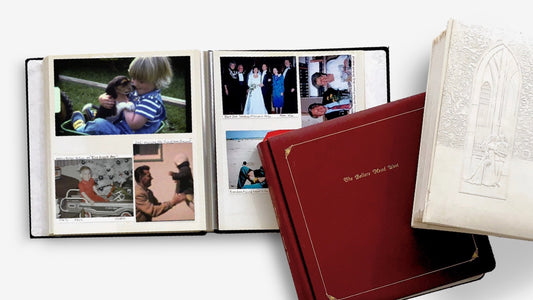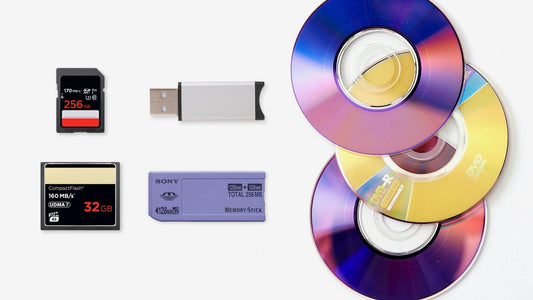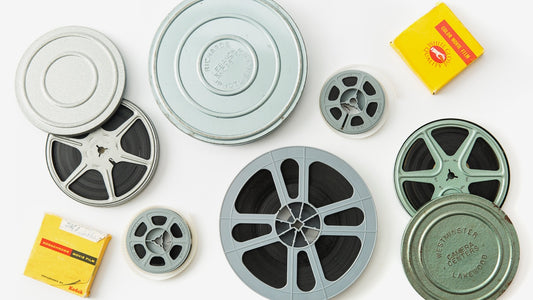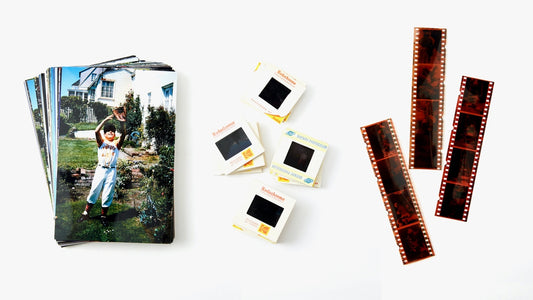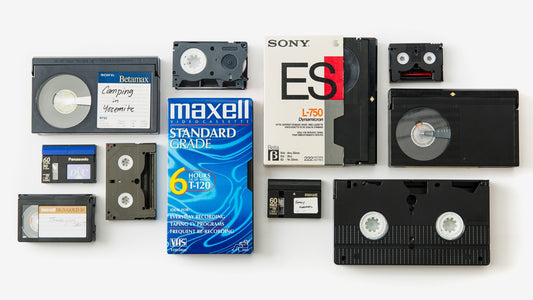If you’ve ever dug through an old camera bag, you might have stumbled upon a thick, sturdy memory card that looks nothing like the tiny SD cards we use today. That little time capsule is likely a CompactFlash card. For years, these were the gold standard for professional photographers and serious hobbyists, chosen for their incredible durability and speed. They were built to protect irreplaceable moments, from a baby’s first steps to a stunning sunset on vacation. Now, that card might be holding forgotten family memories you’d love to see again. Understanding what compactflash cards are is the first step to unlocking those photos and ensuring they’re preserved for good.
Key Takeaways
- Rely on Their Durable Design: CompactFlash cards are built to last with a tough casing and no moving parts, making them a highly reliable option for safeguarding your irreplaceable photos from corruption or damage.
- Choose the Right Specs for Your Camera: To get the best performance, check your camera’s manual for its supported capacity and speed. A faster write speed is essential for shooting action shots or video without any lag.
- Protect Your Investment and Your Memories: Always buy from trusted brands and retailers to avoid fake cards that risk your data. Once you have one, keep it healthy by formatting it in-camera and storing it in a protective case.
What is a CompactFlash Card?
Ever wonder how digital cameras store all those beautiful, high-resolution photos? For many years, the answer has been the CompactFlash (CF) card. Think of a CF card as a small, portable hard drive specifically designed for cameras and other digital devices. First introduced back in 1994, these memory cards became a go-to for professional photographers and videographers because of their reliability and speed.
While you might be more familiar with smaller SD cards, the CompactFlash card has been a workhorse in the digital imaging world for decades. It’s a type of memory card built to handle the large files that come from shooting high-quality photos and videos. If you have a box of old digital media, you might find a few of these inside. Preserving those files is simple with a digital media transfer service that can move your memories from cards to a more modern, shareable format.
How Flash Memory Works
The technology inside a CompactFlash card is called "flash memory." It might sound complex, but the concept is pretty straightforward. Flash memory is a type of storage that doesn't need power to hold onto your data. That’s why you can turn your camera off, take the battery out, and still find all your photos safe on the card later.
Think of it like a digital photo album that never forgets. The memory is made up of tiny cells that can be electrically programmed and erased. This solid-state design is what allows the card to save, access, and delete your files quickly without any moving parts. It’s a stable and efficient way to keep your digital memories secure until you’re ready to view or transfer them.
Design and Durability
One of the biggest reasons professionals have trusted CompactFlash cards for so long is their robust design. These cards are built to last. Unlike older storage media, they have no moving parts, which means there’s less that can break. This solid construction makes them incredibly durable and able to withstand bumps, drops, and even extreme temperatures.
This durability also means CF cards are less likely to suffer from data corruption compared to some other memory card types. When you’re capturing once-in-a-lifetime moments, that extra layer of reliability is a huge plus. Their sturdy build ensures that the photos and videos you capture are kept safe, even when you’re shooting in challenging conditions.
Where You'll Find Them
You’ll most often find CompactFlash cards in high-end and professional-grade digital cameras (DSLRs) and camcorders. Because these devices capture very large files—think stunningly detailed photos or high-definition video—they need a memory card that can write all that data quickly and reliably. The larger size and fast performance of CF cards made them the perfect fit for this job.
While many newer consumer cameras have shifted to smaller card formats, CF cards are still used in some professional equipment today. If you’ve ever used a pro-level camera from brands like Canon or Nikon over the last couple of decades, chances are you’ve handled a CompactFlash card. They are a key piece of technology behind countless professional photos and home movies.
Decoding Types and Speeds
When you start shopping for a CompactFlash card, you'll see a lot of numbers and acronyms. Don't let them intimidate you! Understanding what they mean is pretty straightforward and helps you pick the perfect card for your camera and your memories. Let's break down the key differences in types, speeds, and sizes so you can feel confident in your choice.
Type I vs. Type II Cards
The main difference between Type I and Type II CompactFlash cards is their physical thickness. Type I cards are 3.3mm thick, while Type II cards are a bit chunkier at 5mm. This extra space in Type II cards was originally designed to house tiny hard drives called Microdrives, but that technology is now obsolete. Today, nearly all CF cards you'll find are Type I. They use solid-state flash memory, which is more durable and reliable. So, while you might see slots that fit both types, you'll almost always be shopping for a Type I card. It's a simple distinction, and thankfully, one you don't have to worry about too much.
Understanding UDMA Speeds
You'll often see "UDMA" on CF cards, which stands for Ultra Direct Memory Access. Think of it as a fast lane for your data, allowing your camera to write photos and videos to the card more quickly. The number that follows, like UDMA 7, indicates the mode or speed level—the higher the number, the faster the potential transfer rate. This speed is possible because CF cards are solid-state, meaning they have no moving parts, which makes them incredibly durable. Whether your card is brand new or holds years of memories, it’s a reliable format. If you have older digital media you want to secure, our digital media transfer service can help you preserve those files for the future.
Finding the Right Storage Size
CompactFlash cards come in a wide range of storage capacities, from 32GB to over 512GB. Choosing the right size depends entirely on your needs. If you're shooting high-resolution RAW photos or 4K video, you'll want a larger card, like 128GB or 256GB, to avoid running out of space mid-shoot. For casual photography with JPEGs, a 32GB or 64GB card might be plenty. While CF cards often offer larger capacities than other formats, consider using a few smaller cards instead of one giant one. This way, if a card ever fails or gets lost, you won't lose your entire collection of photos from a trip or event. It’s a simple way to protect your precious memories.
What Do Speed Ratings Mean?
A card's speed rating tells you how quickly it can read and write data. The write speed is the most important one for photographers—it determines how fast your camera can save an image to the card. A faster write speed is essential for burst shooting (taking many photos in a row) and recording high-quality video without hiccups. You'll see speeds listed in MB/s (megabytes per second) or as an "x" rating, like 1066x. This "x" is a multiple of 150 KB/s, the speed of an old CD-ROM drive. Just remember, to get the full benefit of a super-fast card, your camera needs to be able to support those speeds. Pairing a fast card with a capable camera ensures you never miss a shot.
Top Brands to Consider
When you’re shopping for a CompactFlash card, you’ll see a lot of names, but a few consistently stand out for their quality and reliability. Sticking with a reputable brand is one of the best ways to ensure your precious memories are safe. It gives you peace of mind knowing your photos and videos are stored on a card that’s built to last. Here are a few of the top brands to look for.
SanDisk Professional
If you’ve ever shopped for any kind of memory card, you’ve probably come across SanDisk. They are a leader in the market for a reason. Their 64GB Extreme CompactFlash Memory Card is a popular choice among professionals because it’s built for speed. With UDMA 7 technology, it can transfer data at up to 120MB/s. For you, that means you can capture high-resolution photos and videos without frustrating lag. It’s a fantastic option for anyone who wants to shoot crisp, detailed images and smooth video footage.
Lexar Professional
Lexar is another heavyweight in the memory card world, known for producing high-performance cards that professionals trust. Their CompactFlash cards are designed to be incredibly reliable, which is exactly what you need when capturing once-in-a-lifetime moments. Lexar focuses on delivering fast and consistent data transfer speeds, so you can spend less time worrying about your gear and more time focused on getting the perfect shot. If you take your photography or videography seriously, Lexar is a brand you can count on to protect your work.
Transcend
For a great mix of performance and value, Transcend is a brand worth looking at. They offer a range of options that provide a solid balance of speed and storage capacity without the premium price tag. This makes them a popular choice for both amateur photographers and seasoned pros alike. Whether you’re just starting to build your camera kit or need a dependable backup card for a photo shoot, Transcend offers reliable performance that’s accessible to everyone. You’ll often find them among the top-selling CompactFlash cards for good reason.
Comparing Performance and Price
You might notice that CompactFlash cards can be pricier than their SD card cousins, and there’s a good reason for that. The higher price point typically comes down to two key factors: superior speed and durability. CF cards are built to be tougher and faster, which is why professionals have relied on them for years in demanding shooting conditions. For those irreplaceable memories, investing in a more durable card can provide valuable peace of mind. The extra cost often justifies the reliable performance when your memories are on the line.
How CompactFlash Compares to Other Cards
Navigating the world of memory cards can feel like learning a new language, with a whole alphabet of acronyms like SD, CFast, and XQD. While CompactFlash cards have been around for a while, they still hold their own in certain situations. Understanding how they stack up against newer formats helps you appreciate why they were a professional standard for so long and why they might still be the right choice for your camera. It’s all about finding the right tool for the job, whether you’re shooting new photos or accessing old ones.
CompactFlash vs. SD Cards
The most common comparison you’ll see is between CompactFlash and SD cards. The first thing you’ll notice is the size difference. CF cards are noticeably larger and thicker, which contributes to their reputation for being tough and durable. SD cards are tiny in comparison, making them perfect for smaller cameras and devices.
For years, professionals leaned on CF cards for their superior speed and rugged build, which was worth the extra cost. SD cards, on the other hand, typically offer better value for everyday photographers. If you have old photos and videos stored on either of these formats, getting them digitized is a great way to ensure they’re safe. You can easily combine memories from various cards with a digital media transfer service.
The Rise of CFast
Think of CFast cards as the next generation of CompactFlash. While they look similar, they are not interchangeable because they use a much faster internal technology. This new interface allowed for the massive write speeds needed for high-resolution video, making CFast the go-to for professional cinema cameras.
Like the original CF cards, CFast cards are incredibly reliable because they don’t have any moving parts, which reduces the risk of mechanical failure. You’ll mostly find them in high-end video equipment, so for most people with DSLR cameras, the original CompactFlash format is what you’ll be working with.
What About XQD and Newer Cards?
As camera technology continued to advance, even faster memory cards were needed. This led to the development of XQD cards and their successor, CFexpress cards. These formats are the current industry standard for professional photographers and videographers who need blazing-fast speeds to capture high-resolution images and 4K or 8K video without a hitch.
CFexpress cards, in particular, are incredibly fast and strong, built to handle the demands of the latest mirrorless cameras. They represent the cutting edge of memory card technology, carrying on the legacy of performance and reliability that CompactFlash established years ago.
When Should You Choose CompactFlash?
So, with all these newer, faster options, is there still a place for CompactFlash? Absolutely. The number one reason is reliability. CF cards have a solid track record and are less prone to data corruption than some other formats. Their sturdy build also means they can handle a bit more wear and tear.
Many fantastic older DSLR cameras were built specifically for CF cards, and they still take beautiful photos today. If you own one of these cameras, using a high-quality CF card is your best bet for performance and compatibility. Those precious moments captured on your camera deserve a safe home, and a reliable card is the first step before considering a photo transfer to preserve them forever.
Key Features to Look For
Picking the right CompactFlash card isn't just about grabbing one off the shelf. It’s about matching the card’s capabilities to what you want to capture. Whether you're shooting fast-action sports or detailed family portraits, the right card ensures your memories are saved safely and efficiently. Think of it as choosing the perfect photo album before you even take the pictures. Focusing on a few key features will help you find a card that won't let you down when that perfect moment happens. Let's walk through what you need to look for.
Match the Speed to Your Needs
A card's speed determines how quickly it can write (save) and read (access) data. For photographers, a fast write speed is crucial for burst shooting—taking many photos in quick succession—and for recording high-resolution video without lag. A slow card can create a bottleneck, forcing your camera to pause while it catches up. Look for the "write speed" listed in megabytes per second (MB/s). For transferring your files to a computer, a fast read speed will save you a lot of time. Because CF cards have no moving parts, they offer reliable performance, which is exactly what you need when capturing irreplaceable moments.
How Much Capacity Do You Need?
Capacity, measured in gigabytes (GB), tells you how much data the card can hold. The right size depends entirely on what you shoot. If you’re taking high-resolution RAW photos or shooting 4K video, those files will be very large, and you’ll want a card with a higher capacity (64GB or more). For casual JPEG shooting, a smaller card might be sufficient. As a general rule, it’s better to have more space than you think you’ll need. CompactFlash cards often have a capacity advantage over smaller formats, making them a great choice for projects that generate a lot of data, like a long vacation or a wedding.
Industrial vs. Consumer Grade
You might see cards labeled as "industrial" or "professional" grade. What’s the difference? It comes down to durability and reliability. Industrial-grade cards are built to withstand more extreme temperatures, shocks, and vibrations. They also often have more advanced error-correction technology, making them less prone to data corruption. While they come with a higher price tag, investing in a professional-grade card can provide extra peace of mind, especially if you're shooting in challenging environments or capturing a once-in-a-lifetime event. For everyday use, a standard consumer-grade card from a reputable brand is usually perfectly fine.
Check for Compatibility
This might be the most important step of all. Not every CF card works with every camera. Before you buy, check your camera’s manual or the manufacturer’s website to see what types of cards it supports. Pay attention to the maximum capacity (some older cameras can't handle high-capacity cards) and the speed protocol (like UDMA 7). Forcing the wrong card into your camera can damage the delicate pins inside the card slot, leading to a costly repair. It’s a simple check that can save you a lot of frustration and protect both your gear and your precious digital media.
Get the Most From Your Card
A good CompactFlash card is an investment in your memories. To make sure it performs reliably for years to come, it helps to follow a few best practices. From proper handling to smart data management, these simple habits can protect your photos and extend the life of your card. Taking care of your CF card is just as important as taking care of your camera, ensuring every moment you capture is safe and sound.
How to Handle and Store Your Cards
Think of your CF card like a tiny, precious book of memories—it deserves a good cover. Keep your cards in protective cases to shield them from dust, moisture, and accidental drops. This simple step prevents the metal contacts from getting scratched or dirty, which can cause read errors. It’s also a great idea to label your cases so you can quickly grab the right card for the job or know which ones are full. When you've filled a card with photos, the next step is getting them onto a computer and backed up. For long-term security, a digital media transfer service can create a permanent archive of your most important files.
Protect Your Precious Data
Here’s a pro tip that can save you a lot of headaches: always format your memory cards in your camera, not on your computer. Formatting prepares the card to work best with your specific camera, creating a file structure it understands perfectly. This can prevent data corruption and other frustrating errors. Another key habit is to wait for the camera’s activity light to turn off before removing the card, as pulling it out mid-write can damage your files. And remember, don't let your card be the only place your photos live. Make it a habit to back up your files after every shoot. This simple step is the best insurance for your irreplaceable moments.
Troubleshoot Common Problems
Before you take a new card on a once-in-a-lifetime trip or to an important event, give it a test run at home. Shoot a few photos and videos to make sure it works seamlessly with your camera. If a card ever starts giving you error messages or feels unusually sluggish, it’s best to replace it right away. While you can try it in a different card reader to rule out other issues, don't risk your memories on a failing card. Think of them as having a finite lifespan, and plan to retire them after a few years of heavy use. It's a small price to pay for peace of mind.
Tips for Professional Use
For professional photographers, reliability is everything. That's where CompactFlash cards really shine. Their durable build and consistent high speeds are worth the extra cost for pros who can't afford a card failure during a wedding or commercial shoot. Many photographers also prefer using several smaller-capacity cards rather than one huge one. This way, if a card happens to fail, you only lose a portion of your shoot, not the entire day's work. It’s a simple strategy that provides a huge safety net for those can't-miss moments, much like how families used to preserve memories on individual reels before getting a film transfer to consolidate them.
Common CompactFlash Myths, Busted
CompactFlash cards have been a staple for photographers for decades, and like any long-standing technology, they’ve collected a few myths along the way. You might have heard they’re too slow, too fragile, or just plain obsolete. It’s time to set the record straight. Let’s look at some of the most common misconceptions and separate the facts from the fiction.
Myth: They're Slow and Outdated
While it’s true that newer card formats like CFexpress have hit the market with blazing-fast speeds, it’s a mistake to write off CompactFlash cards as slow. High-end CF cards, especially those with a UDMA 7 rating, still offer impressive read and write speeds that are more than enough for professional photography and high-definition video. Many photographers consider them a professional standard because they balance speed with proven reliability. For most practical uses, a quality CF card performs beautifully and won’t be the bottleneck in your creative process. They’ve stuck around for a reason: they just work.
Myth: They Can't Handle Tough Conditions
This one couldn’t be further from the truth. CompactFlash cards are actually known for their robust and durable design. Unlike delicate hard drives, they are solid-state media, meaning they have no moving parts. This makes them incredibly resilient to shocks, vibrations, and drops. Their larger, thicker casing also provides more physical protection than you’d get from a smaller, thinner SD card. This durability makes them a trusted choice for photographers working in challenging environments, from dusty landscapes to freezing temperatures. Your memories are safer on a CF card than on many other types of media.
Myth: They're Only for Old Cameras
It’s easy to associate CompactFlash cards with older DSLR cameras, but they are far from being relics. Many professional-grade cameras from leading brands like Canon and Nikon still include CF card slots, often alongside a slot for a newer card type. This is because pros value the reliability and proven performance that CF cards offer. So, while you might find them in a camera from ten years ago, you’ll also find them in the gear bags of working photographers today. They remain a relevant and practical choice for high-end digital photography.
Myth: They Aren't a Good Investment
When you consider their durability and large storage capacities, CompactFlash cards offer excellent value. They often provide a lower cost per gigabyte compared to the newest card formats, making them a budget-friendly option for serious hobbyists and professionals. The real investment, however, is the precious memories stored on them. A reliable card that protects your photos and videos for years is always a smart choice. If you have older CF cards filled with family moments, you can ensure they last forever with a digital media transfer that moves them to a modern, easily shareable format.
How to Buy the Right Card
Once you know what features you need, it’s time to make a purchase. But with so many options and retailers, finding the right card can feel overwhelming. The last thing you want is to lose your precious photos or videos to a faulty or fake card. Let’s walk through how to buy with confidence, ensuring your memories are stored safely until you’re ready to enjoy them for years to come.
Find Trusted Retailers and Warranties
The best way to protect your purchase is to buy from a reputable source. Stick with well-known brands like SanDisk, Lexar, Transcend, and ProGrade, as they have a long history of reliability. It’s just as important to buy from trusted retailers, whether online or in-store. Big-box electronics stores or dedicated camera shops are your safest bet. They have direct relationships with manufacturers, which means you’re getting the real deal. Plus, buying from an authorized dealer ensures your card’s warranty is valid, giving you a safety net if anything goes wrong.
How to Spot a Fake
Counterfeit memory cards are out there, and they can cause major headaches, from slow performance to complete data loss. To avoid them, be wary of prices that seem too good to be true, especially on auction sites or unfamiliar online marketplaces. Always inspect the packaging—fake cards often have blurry printing, typos, or flimsy packaging that’s easy to tear. The card itself might also feel lighter or have a poorly printed label. Your best defense is simply to purchase from a reputable store, which nearly eliminates the risk of ending up with a fake.
Find the Best Price
You don’t have to break the bank to get a great CompactFlash card. Prices vary widely depending on the brand, storage size, and speed. A smaller, older card might cost less than $10, while a high-capacity, professional-grade card can run closer to $100 or more. Keep an eye out for sales at major retailers, especially around holidays. It’s also a good idea to compare prices online before you buy. Just remember to balance cost with reliability. Saving a few dollars isn’t worth it if you’re buying from a shady seller and risking the photos you’ll one day want to transfer to digital.
Should You Buy a Bundle?
Sometimes you’ll see cards sold in bundles, either as a multi-pack or with accessories like a card reader. Multi-packs can be a good deal if you know you’ll need multiple cards for a long trip or a big project. When considering a single card, think about paying a little extra for enhanced durability. Some cards are built to be water-resistant, shockproof, and able to withstand extreme temperatures. If you often shoot in challenging environments, investing in a rugged card like the SanDisk Extreme PRO can provide valuable peace of mind, protecting your memories no matter where you take them.
Related Articles
- Photo Slides: A Comprehensive Guide (2023)
- Digitize Photos: The Ultimate Guide for 2024
- 6 Best 8mm Film Converters (Buyer's Guide)
- Digitize Slides: The Ultimate 2025 How-To Guide
Frequently Asked Questions
Will any CompactFlash card work in my camera? Not necessarily. It's really important to check your camera's manual or the manufacturer's website first. Older cameras might not be able to handle the huge storage capacities of modern cards, and they may not support the fastest speeds. Taking a moment to confirm compatibility will save you from potential frustration and can prevent damage to your camera's card slot.
Why are CF cards so much bigger than the SD cards I'm used to? That larger size is actually one of their biggest strengths. The thicker, more robust casing was designed for durability, which is why professional photographers trusted them for so long in all sorts of conditions. Think of it as extra armor for your memories. While SD cards are convenient for smaller devices, the solid build of a CF card gives it an edge in toughness.
Do CompactFlash cards wear out? Yes, like all flash memory, they have a finite lifespan. While they are built to be very durable and can last for many years, they aren't meant for permanent, forever storage. Each memory cell can only be written to and erased a certain number of times. For this reason, it's best not to rely on a card as your sole backup. Once you've filled a card with precious photos, the safest next step is to transfer those files to a more permanent home.
What's the best way to get photos off an old CF card? The most direct method is to use a USB card reader. These are simple devices that you plug into your computer, allowing you to insert the CF card and transfer files just like you would from a regular flash drive. This lets you easily back up your photos to your computer or an external hard drive, ensuring they are safe and accessible.
I found some old CF cards with family photos. What's the safest way to preserve them? Finding old cards like that is like discovering a time capsule. The best way to ensure those memories last for generations is to get them off the card and into a modern digital format. Transferring the files to a cloud service or a dedicated digital archive protects them from being lost if the card eventually fails. This also makes it incredibly easy to view, share, and enjoy those moments with your family again.






